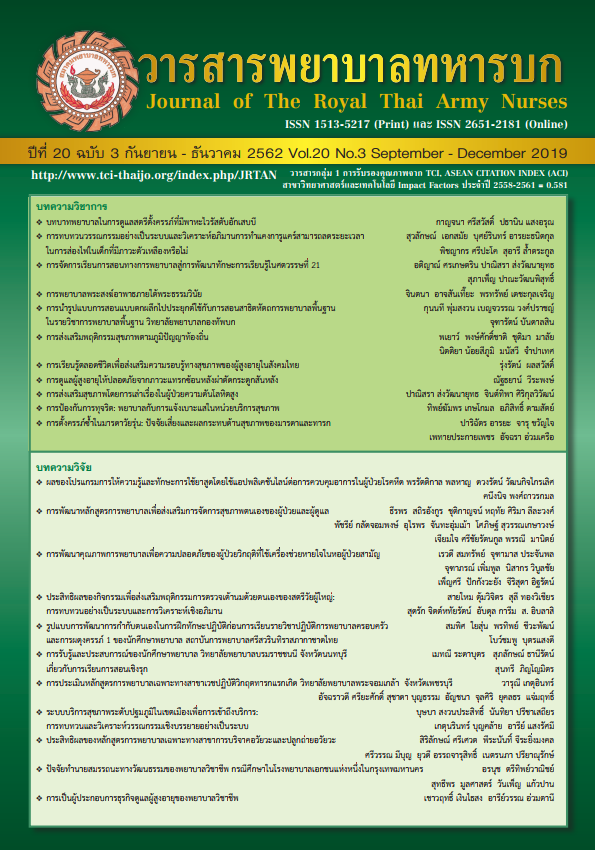Acessibility Enhancing Urban Primary Care Service Systems: Systematic Review and Narrative Synthesis
Keywords:
urban areas, primary care service system, accessibilityAbstract
Accessibility to primary care services in urban areas remained an important public health problem in Thailand. Main factor contributing to this problem was fast growing urbanization, resulting in inadequate infrastructure and public services. This study aimed to systematically review research studies and projects relating to provision of primary care services in urban areas which successfully increased people’s accessibility; to analyze promoting methods used in these studies and projects; and to make recommendations on improving urban primary care service systems in Thailand. Nine officially evaluated research articles and projects in both developed and developing countries, published during 2005 – 2018 were included in the study. Systematic review and narrative analysis were used for data analysis. The results revealed five classified diverse methods used to increase the accessibility and utilization of primary care services in the urban areas; these were facilitating the accessibility, motivating the utilization, promoting methods, reducing needs for treatment, and quality control and cost containment. The most important element that was an integral part of all methods was the participation of all sectors: public, private, NGOs, community, and family, and at all levels. It was found that the methods used in these studies depended on social, cultural and political contexts and the levels of economic and education advancement of each area.
Downloads
References
2. Koocharoenprasit S, Siriwanarangsun P. Primary Care Service System in Urban Setting: A case study in Bangkok area, B.E. 2560. Journal of the Preventive Medicine Association of Thailand. 2018; 8(2): 182-190. (in Thai)
3. Boonsuya C, Suwanapong N. Health status of Bangkok residents: A comprehensive study project. Bangkok: Faculty of Public Health. Mahidol University; 2013. (in Thai)
4. Ministry of Public Health. Office of the Permanent Secretary of Public Health. General Health Information. Nonthaburi: Office of the Permanent Secretary; 2013. (in Thai)
5. National Health Commission Office. The 8th National Health Forum 13 November 2015. The Commission; 2015. (in Thai)
6. World Health Organization. Southeast Asia Region Office. Regional Consultation on Health of the Urban Poor 13-15 October 2010. SEA-HSD-345. New Delhi: WHO/SEARO; 2011.
7. UN-HABITAT. United Nations Human Settlements Programme. Cities and Climate Change: Global Report on Human Settlements. Washington DC: Earthscan; 2011.
8. Popay J, Roberts H, Sowden A, Petticrew M, Arai I, Rodgers M, et al. Guidance on the Conduct of Narrative Synthesis in Systematic Reviews: A Product from the ESRC Methods Programme. Bailrigg: Lancaster University; 2006.
9. EPPI-Centre. Methods for conducting systematic reviews. London: EPPI-Centre, Social Science Research Unit. Institute of Education. University of London; 2006.
10. Hayman N E, While N E and Sparling G K. Improving Indigenous patients’ access tomainstream health services: the Inala experience. Medical Journal of Australia. 2009; 190(10): 604-606.
11. Greer, P. Urban Clinic Provides Free, Bilingual Primary and Specialty Care to the Uninsured and Underserved of Miami-Dade County. Agency for Health Research and Quality. Rockville: MD; 2015.
12. Datta D, Kouletio M, and Rahman T. Developing urban health systems in Bangladesh in Participatory learning and action. Geneva: World Health Organization; 2005.
13. Bhat R, Mavalankar D, Maheshwari S, Saha S. Provision of Reproductive Health Services toUrban Poor through Public-Private Partnerships: The Case of Andhra Pradesh Urban Health Care Project W.P. No.2007-01-07. Indian Institute of Management. Ahmedabad: India; 2007.
14. Whitelaw N, Warden G, Wenzler M. Current Efforts towards Implementation of an Urban Health Strategy: The Henry Ford Health System. Journal of Urban Health Bulletin of the New York Academy Medicine. 1998; 75(2): 356-366.
15. Liu G G. Vortherms SA, Hong X. China’s Health Reform Update. Annu. Rev. Public Health 2017; 38:431-48.
16. Wang X, Sun X, Birch S, Gong F, Valentijn P, Chen L, et al. People-centered integrated care in urban China. Bull World Health Organ. 2018;96(12):843-852.
17. World Health Organization. Regional Office for the Eastern Mediterranean. Good practices in delivery of primary health care in urban settings: Oman. Community-Based Initiative Series 15. 2012: 23-37.
18. Kraikajonkiti J. The Effectiveness of the Improvement of the Out Patient Department of Prae Hospital and primary network. Proceeding in 3rd R2R Conference. 15 July 2010. (in Thai)
19. Ritsatakis A, Ostergren P, Webster P. Tackling the social determinants of inequalities in health during Phase V of the Healthy Cities Project in Europe. Health Promotion International. 2015;30(S1): i45 – i53.
20. Nursing Effectiveness, Utilization and Outcomes Research Unit. Faculty of Nursing. University of Toronto. Fact Sheet: What Factors Can Influence Health Care Utilization?; 2019.
21. Pantaewan P. Nursing Role and Sustainable Development Goal (SDGs). Journal of The Royal Thai Army Nurses 2019; 20(2): 33–43. (in Thai)
22. Udomlap R. Role of Nurse in Decrease Burden of Caregivers of Older Persons with Dementia. Journal of The Royal Thai Army Nurses 2019; 20(2): 26–32. (in Thai)
23. Artsanthia J, Pomthong R. The trend of Elderly Care in 21st Century: Challenging in Nursing Care. Journal of The Royal Thai Army Nurses 2018; 19(1): 39–46. (in Thai)
24. World Health Organization/Southeast Asia Region Office. (2009). Self-care in the Context of Primary Health Care. Report of the Regional Consultation, Bangkok, Thailand. New Delhi:WHO/SEARO; 2009.
Downloads
Published
How to Cite
Issue
Section
License
บทความหรือข้อคิดเห็นใดใดที่ปรากฏในวารสารพยาบาลทหารบกเป็นวรรณกรรมของผู้เขียน ซึ่งบรรณาธิการหรือสมาคมพยาบาลทหารบก ไม่จำเป็นต้องเห็นด้วย
บทความที่ได้รับการตีพิมพ์เป็นลิขสิทธิ์ของวารสารพยาบาลทหารบก
The ideas and opinions expressed in the Journal of The Royal Thai Army Nurses are those of the authors and not necessarily those
of the editor or Royal Thai Army Nurses Association.






